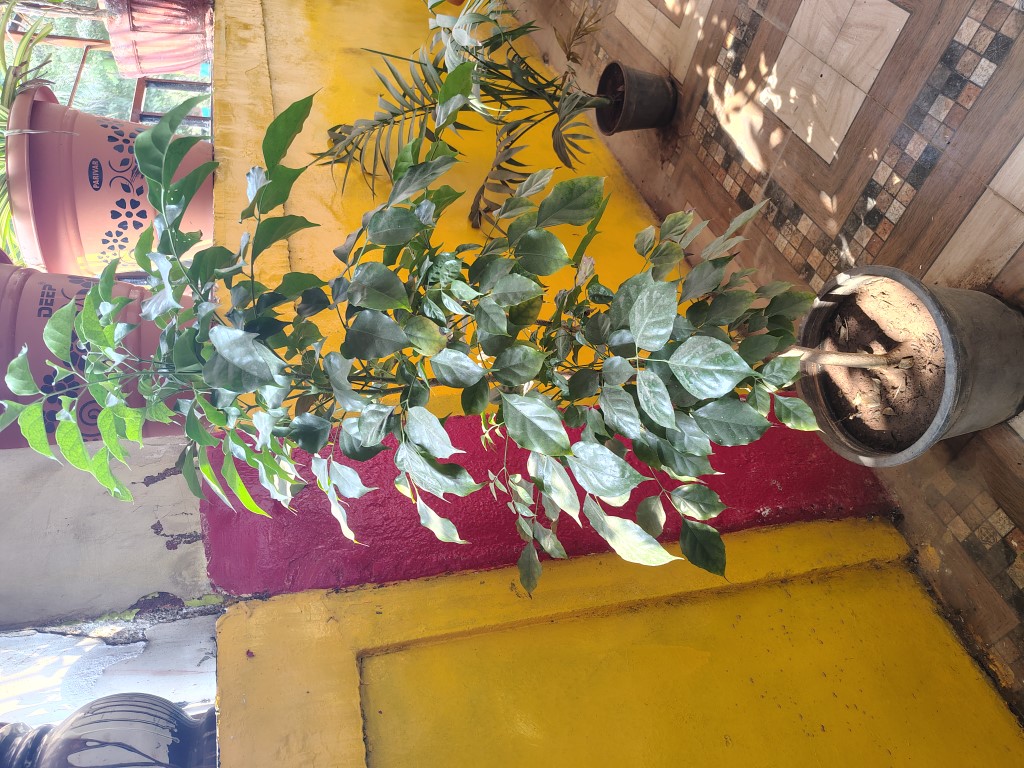Green Campus/Tree Details

शेफ्लेरा (Schefflera )
Schefflera या वनस्पतीला मराठीत "शेफ्लेरा" किंवा "अंबल पाम" असे ओळखले जाते. याला काही ठिकाणी "पार्लर पाम" असेही म्हटले जाते, पण हे नाव सहसा Chamaedorea elegans या पामसाठी वापरले जाते. शेफ्लेरा म्हणजेच त्या गुळगुळीत पानांसह असलेली एक आकर्षक सजावटीसाठी वापरली जाणारी झाडं आहे.
Schefflera विषयी माहिती:
- वैज्ञानिक नाव: Schefflera
- कुटुंब: Araliaceae
- साधारण मराठी नाव: शेफ्लेरा, अंबल पाम
वैशिष्ट्ये:
- पाने: शेफ्लेरा झाडाची पाने मोठी, चमकदार आणि लांबट असतात. त्याच्या पानांची रचना सुंदर आणि आकर्षक असते, आणि काही जातींमध्ये पानांवर विविध रंगांचे धारे किंवा ठिपके असतात.
- उंची: शेफ्लेरा साधारणपणे 4 ते 6 फूट उंच होऊ शकते, परंतु काही प्रकार 10 फूटांपर्यंत वाढू शकतात.
- फुलांचा रंग: हे झाड साधारणतः घरात फुलत नाही, पण त्याची पानं आणि झाडाचा आकार मोठ्या आकाराचे आणि आकर्षक दिसतात.
वाढवण्याचे वातावरण:
- सूर्यप्रकाश: शेफ्लेरा पामला अप्रत्यक्ष किंवा मध्यम सूर्यप्रकाश लागतो. थेट सूर्यप्रकाशामुळे पानांवर जळजळ होऊ शकते.
- पाणी: पाणी देताना माती ओलसर ठेवणे महत्त्वाचे आहे, पण ओलसरपणा जास्त होईल असं टाळा. माती कोरडी होण्याआधी पाणी द्यायला हवे.
- तापमान: 18°C ते 25°C तापमानात या झाडाचा चांगला विकास होतो. थंड वातावरण किंवा जास्त थंड वाऱ्यांपासून ते सुरक्षित ठेवावे.
सजावटीसाठी उपयोग:
- शेफ्लेरा घर, ऑफिस आणि इतर इनडोअर जागांसाठी चांगली सजावटीची वनस्पती आहे. याचे आकर्षक पाणी शोषक पाले कोणत्याही खोलीस सौंदर्य आणि ताजेपणा देतात.
देखभाल:
- पाणी: माती थोडी कोरडी झाल्यावरच पाणी द्यावे. अधिक पाणी दिल्यामुळे मुळांमध्ये सडपातळ होण्याची शक्यता असते.
- फुलवणी: घरात शेफ्लेरा झाड फुलत नाही, पण त्याच्या पानांची रचना आणि आकारच मुख्य आकर्षण आहे.
सारांश:
Schefflera किंवा अंबल पाम हे आकर्षक, कमी देखभाल करणारे आणि घरातील सजावटीसाठी उपयुक्त झाड आहे. याची पानांची रचना, साधारण वाढ आणि थोड्या देखभालीत देखील चांगली वाढ ही त्याची खासियत आहे.
Schefflera
Key Features:
-
Appearance:
- Leaves: Schefflera plants are known for their large, glossy, palmate (umbrella-shaped) leaves. The leaves are typically dark green, though some varieties have variegated foliage with yellow or white streaks.
- Height: It can grow up to 4 to 6 feet (1.2 to 1.8 meters) indoors, but some species may reach up to 10 feet (3 meters) tall in ideal conditions.
- Growth Habit: Schefflera can be grown as a small tree or large shrub, and its bushy appearance makes it perfect for filling empty corners in homes or offices.
-
Light Requirements:
- Bright, Indirect Light: Schefflera thrives in bright, indirect light but can tolerate lower light levels. However, its growth may slow down, and its leaves may lose some vibrancy in low light.
- Avoid Direct Sunlight: Direct sunlight can scorch the leaves, so it's best to place the plant in a spot with filtered or indirect light.
-
Watering:
- Moderate Watering: Keep the soil evenly moist but not soggy. Allow the top inch of soil to dry out before watering again. Overwatering or letting the plant sit in stagnant water can lead to root rot.
- Humidity: Schefflera prefers moderate humidity but can tolerate average indoor levels. Occasionally misting the plant or placing it on a humidity tray can help if the air is too dry.
-
Temperature:
- Warm Temperatures: The plant prefers temperatures between 65°F to 75°F (18°C to 24°C). It should be protected from cold drafts and temperatures below 50°F (10°C), as it is sensitive to frost.
-
Soil:
- Well-draining Soil: Schefflera does best in well-draining potting soil, preferably a mix designed for indoor plants that retains moisture without becoming soggy.
Maintenance and Care:
-
Pruning:
- Pruning can be done to shape the plant and remove any dead or damaged leaves. If the plant becomes too tall or leggy, it can be trimmed back to encourage more compact growth.
- Schefflera can also be cut back to maintain a desirable shape, and trimming helps promote a fuller, bushier appearance.
-
Repotting:
- Schefflera grows fairly slowly, but it will need to be repotted every 2-3 years or when it outgrows its current container. Repotting helps ensure the plant has enough space for root growth and continues to thrive.
-
Fertilizing:
- Fertilize Schefflera every 4-6 weeks during the growing season (spring and summer) with a balanced liquid fertilizer. Reduce feeding during the dormant winter months.
-
Pests:
- While relatively pest-resistant, Schefflera can occasionally be affected by spider mites, scale insects, and mealybugs. Regularly wiping the leaves with a damp cloth and inspecting for pests can help prevent infestations.
Common Problems:
- Yellowing Leaves: Yellowing leaves can indicate overwatering, insufficient light, or a nutrient deficiency. Ensure the plant is receiving adequate light and that the soil is not too wet.
- Leaf Drop: If the plant drops leaves, it could be due to a sudden change in temperature, drafts, or stress from overwatering or underwatering.
- Leggy Growth: Lack of light or insufficient pruning may result in leggy growth. Move the plant to a brighter spot and trim back any long, spindly stems.
Benefits:
- Air Purification: Like many houseplants, Schefflera helps purify indoor air by removing toxins such as formaldehyde and benzene.
- Aesthetic Appeal: The large, glossy leaves and attractive shape make it a popular choice for both home and office decor. It can add a lush, tropical look to any space.
Where to Grow:
- Indoor: Schefflera is an excellent choice for growing indoors. It is commonly found in homes, offices, and commercial spaces. Its tolerance for lower light conditions makes it suitable for indoor environments.
- Outdoor: In tropical and subtropical regions, Schefflera can be grown outdoors as a landscaping plant. However, it is sensitive to frost and should be protected from freezing temperatures.
Conclusion:
Schefflera, or the Umbrella Tree, is a stylish and low-maintenance plant that can thrive indoors with minimal care. Its large, glossy leaves and tree-like structure make it an ideal addition to living rooms, offices, and other indoor spaces. With its ability to tolerate a variety of light conditions and its attractive, easy-to-care-for nature, it’s no wonder Schefflera is a favorite for both novice and experienced plant owners alike.
